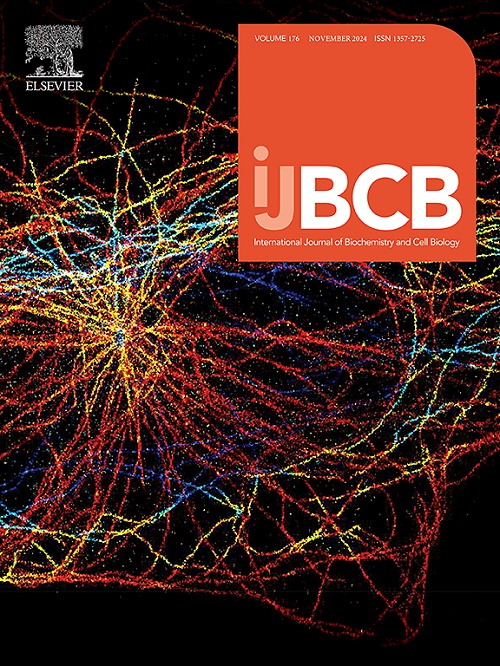Ethacrynic acid inhibits the growth and proliferation of prostate cancer cells by targeting GSTP1 and regulating the PI3K-AKT signaling pathway
IF 2.8
3区 生物学
Q2 BIOCHEMISTRY & MOLECULAR BIOLOGY
International Journal of Biochemistry & Cell Biology
Pub Date : 2025-02-01
DOI:10.1016/j.biocel.2025.106740
引用次数: 0
Abstract
Background
As a diuretic, ethacrynic acid (EA) has been shown to play a suppressive role in cancers, including prostate cancer (PC). However, its molecular regulatory mechanism is still unclear. Therefore, our study is centered on investigating the effect of EA on PC development and its mechanism.
Methods
To verify the binding relationship between EA and GSTP1, molecular docking and cellular thermal shift assay (CETSA) were conducted. To examine how EA affects PC cell proliferation, cell cycle, and apoptosis, cell function assays were performed. qRT-PCR was used to detect GSTP1 mRNA expression. The expression of GSTP1 protein and PI3K-AKT signaling pathway-related proteins in cells was detected by western blot (WB). To verify how EA and GSTP1 influence cell growth in PC, in vivo experiments were conducted.
Results
The binding relationship between GSTP1 and EA was confirmed by molecular docking and CETSA results. Cell experiments showed that EA could hinder PI3K/AKT pathway and PC cell proliferation, arrest the cell cycle in G0/G1 phase, and facilitate apoptosis by binding to GSTP1. In vivo experiments in nude mice verified that the interaction between EA and GSTP1 reduced PI3K and AKT phosphorylation and inhibited the growth of PC cells.
Conclusion
EA inhibits PC progression by binding to GSTP1 to downregulate the activity of PI3K/AKT pathway, and this result suggests the potential of EA to be an anticancer agent for PC therapy.
乙丙酸通过靶向GSTP1,调控PI3K-AKT信号通路抑制前列腺癌细胞的生长和增殖。
背景:作为一种利尿剂,乙酸(EA)已被证明在包括前列腺癌(PC)在内的癌症中发挥抑制作用。然而,其分子调控机制尚不清楚。因此,我们的研究重点是探讨EA对PC开发的影响及其机制。方法:通过分子对接和细胞热移实验(CETSA)验证EA与GSTP1的结合关系。为了研究EA如何影响PC细胞增殖、细胞周期和凋亡,进行了细胞功能测定。采用qRT-PCR检测GSTP1 mRNA的表达。western blot (WB)检测细胞中GSTP1蛋白和PI3K-AKT信号通路相关蛋白的表达。为了验证EA和GSTP1如何影响PC细胞生长,我们进行了体内实验。结果:通过分子对接和CETSA结果证实了GSTP1与EA的结合关系。细胞实验表明,EA可抑制PI3K/AKT通路,抑制PC细胞增殖,使细胞周期停留在G0/G1期,并通过与GSTP1结合促进细胞凋亡。裸鼠体内实验证实EA与GSTP1的相互作用降低了PI3K和AKT的磷酸化,抑制了PC细胞的生长。结论:EA通过与GSTP1结合,下调PI3K/AKT通路活性,抑制PC的进展,提示EA可能是一种用于PC治疗的抗癌药物。
本文章由计算机程序翻译,如有差异,请以英文原文为准。
求助全文
约1分钟内获得全文
求助全文
来源期刊
CiteScore
8.10
自引率
0.00%
发文量
124
审稿时长
19 days
期刊介绍:
IJBCB publishes original research articles, invited reviews and in-focus articles in all areas of cell and molecular biology and biomedical research.
Topics of interest include, but are not limited to:
-Mechanistic studies of cells, cell organelles, sub-cellular molecular pathways and metabolism
-Novel insights into disease pathogenesis
-Nanotechnology with implication to biological and medical processes
-Genomics and bioinformatics

 求助内容:
求助内容: 应助结果提醒方式:
应助结果提醒方式:


